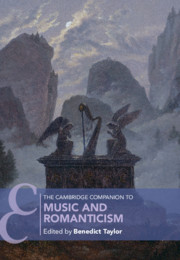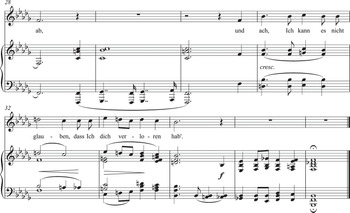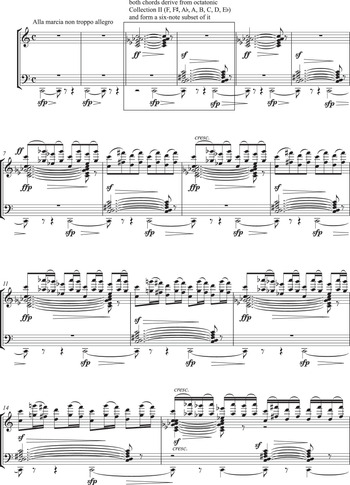Introduction
Applying linguistic analogies to music is inevitably a precarious activity. The idea that we can usefully characterise a composer’s musical ‘language’ is a musicological commonplace; the analogy has variously encompassed melodic style, harmony, approaches to form and genre, and expressive means and objectives, as well as more ambitious claims that music and language are somehow synonymous. Yet few commentators accept the functional synonymy of music and language uncritically. Research in the fields of musical semiotics, expression, and narrativity has not established any precise linguistic function for music; and linguistic models of musical meaning of the sort attempted by Deryck Cooke seem doomed to failure.1
This analogy is nevertheless crucial to any consideration of music and Romanticism. As Benedict Taylor makes clear in this volume’s opening chapter, a new interest in the relationship between music and literature and a belief that music can fulfil poetic, dramatic, and narrative aspirations without the need for written language are defining factors of music’s Romantic turn. These convictions rely on a complex mediation of musical and extra-musical factors. In one sense, Romantic music is marked by a retreat from extra-musical meaning: Beethoven, above all, comes to be associated with the concept of autonomy, by which is generally meant the liberation of music from textual and social dependencies and a consequent freedom to pursue its own self-reflective ambitions.2 At the same time, autonomy facilitates a perception of music as the purveyor of higher meanings: precisely because instrumental music coheres without textual support, it can convey conceptual essences without the intervention of written or spoken language. This is absolute music’s aesthetic precept: textless music accesses narrative and poetic ideas directly, without recourse to language.
This chapter offers three case studies of Romanticism’s musical ‘language’, understood as the melodic, harmonic, and formal means that composers deployed to expressive ends. The first and second case studies – melody in Beethoven and Field, and harmony from Schubert to Brahms – deal with aspects of what could, by analogy, be called Romanticism’s vocabulary and grammar, paying attention to compositional materials, the logic of their employment, and the sources from which they arise. The third – the Finale of Schumann’s Symphony No. 2 – turns to matters of form specifically to address the relationship with literature, and therefore isolates narrative as well as purely formal strategies (questions of Romantic form are addressed by Steven Vande Moortele in Chapter 15). Connecting these studies is the common theme of Romanticism’s new-found musical self-awareness. The thematic habits of Beethoven’s middle period betray a degree of overt intellectual self-reflection in excess of eighteenth-century precedent; harmonic experimentation develops alongside an emerging theoretical understanding of music’s systems as well its practices; and Schumann’s symphonic-literary sensibility is enabled by reflection on the idea of a symphony as well as its generic requirements.
Melody, Theme, and Texture
Romanticism’s attitude towards melody is characterised by contrasted, if not contradictory, tendencies. Composers accorded new importance to lyric and rhapsodic styles, emphasising a degree of freedom that went beyond classical conventions and devising novel vehicles for its expression. At the same time, they also placed a heightened value on thematic and motivic coherence, pursuing cyclical integration and developmental processes in instrumental compositions especially. To an extent, these tendencies evidence the polarised priorities of vocal and instrumental music, which Carl Dahlhaus housed under the contentious ‘style dualism’ of Rossinian opera and Beethovenian instrumental music.3 Yet this duality conceals a more nuanced reality: composers in Beethoven’s shadow found new ways of imitating vocality; and lyrically inclined genres emerged, which are impossible to classify into straightforward national schools.
That the lyric strain of Romantic melody evades simple explanation is aptly demonstrated by the development of the nocturne. Credit for its invention as an instrumental genre is invariably given to John Field, whose sixteen contributions were published between 1812 and 1836, but this origin myth masks complex circumstances: Field did not ‘invent’ the nocturne in an act of Romantic innovation. Many of the pieces he eventually published as nocturnes began life under other titles, which sometimes indicate a debt to the eighteenth-century notturno (‘serenade’) and sometimes do not (‘pastorale’, ‘romance’).4 In some cases, stand-alone nocturnes migrated from other genres entirely: the Nocturne No. 12 in G is, for example, also a slow episode in the first movement of Field’s Piano Concerto No. 7. More properly, we can see the piano nocturne as coalescing from various generic and stylistic sources. Its melody-and-accompaniment idiom derives from the high-classical singing style, crucially augmented by the pedalling technology that allowed pianists to displace the bassline from the interior texture by more than an octave.5 Vocal precedents are folded into the genre – the operatic serenade and bel canto fioritura are often cited – but in Chopin’s hands especially, the title accommodates a broad range of implied genres.6
The nocturne’s Romantic credentials, and Field’s status as its progenitor, were secured by Franz Liszt, whose preface to the first collected edition nominated the pieces as seminal for musical Romanticism. For Liszt, it was to Field’s unique sensibility that ‘we owe the first essays which feeling and revery ventured to make on the piano, to free themselves from the constraints exercised over them by the regular and official model imposed until that time on all compositions’. Before Field, ‘It was formally necessary that they should be either Sonatas or Rondos etc.; Field was the first to introduce a species which belonged to none of the established classes, and in which feeling and melody reigned alone, liberated from the fetters and encumbrances of a coercive form.’7 Liszt’s claims are hard to categorise within Dahlhaus’s dualism. Field’s style is clearly vocal, but also distant from Rossinian opera’s formulae and overt display. Liszt subsequently emphasises Field’s lyricism, thereby associating him more closely with Schubert; but there is nothing in Field that suggests poetic dependency or an anchorage in art song. And Liszt’s Field is even more distant from the instrumental style that Dahlhaus valorised in Beethoven. Field also falls outside Dahlhaus’s geographical remit, as a representative of the so-called ‘London pianoforte school’, the influence of which was both widespread and distinct from both Austro-German and Franco-Italian genealogies. Nevertheless, as a progenitor of Romanticism, Field is arguably more important than any of these precursors, since, for Liszt, it is to Field that Romanticism owes all of those genres that are specifically post-classical.
Brief comparison of Field’s Nocturne No. 1 in E flat of 1811 with the first movement of Beethoven’s ‘Tempest’ Sonata, Op. 31 No. 2 of 1801 makes clear the sheer distance between Field’s aesthetic and Beethoven’s motivic style. The first movement of the ‘Tempest’ has become an exemplar of Beethoven’s middle-period intellectualism. Dahlhaus repeatedly observed the novelty of its opening, shown in Ex. 14.1, which moves from introduction to transition without ever establishing a stable main theme.8 More recently, Janet Schmalfeldt has explained this as an example of ‘becoming’, or the retrospective reinterpretation of formal function. On first hearing, bar 21 seems to initiate a main theme, because it is the first unequivocal downbeat, which establishes a root-position tonic. By bar 41, however, it has become clear that bar 21 initiates a transition, not a theme, which means that we have to mentally revisit bars 1–21 and reinterpret them as thematic.9
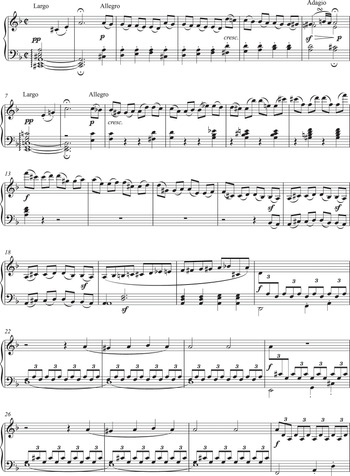

Example 14.1 Beethoven, ‘Tempest’ Sonata, Op. 31 No. 2 (1801), i, bb. 1–41
Dahlhaus and Schmalfeldt consider Beethoven’s innovation here to be the creation of a dialectical formal concept, which collapses formal function into process. The material’s identity is not confirmed with its presentation; instead, Beethoven forces his listener to reconsider and discard perceptions of formal function as the music proceeds. Because we have to convert a main theme into a transition, we also have to convert an introduction into a main theme. All of this happens retrospectively and speaks to a kind of form, in which the listener is an active participant. As a result, the ‘Tempest’ transforms the formal functions of sonata form from genre markers (‘I know we are listening to a piano sonata, because I hear a main theme and transition’) into objects of conscious reflection (‘I am invited to participate in the construction of the main theme and transition as I hear them, as well as acknowledging their generic circumstances’). Both Dahlhaus and Schmalfeldt are quick to point out the parallels with contemporaneous philosophy. The notion of a consciously critical art was central to Friedrich Schlegel’s idea of the Romantic fragment; and it is easy to see resonances with Hegel’s coming-to-self-consciousness of the spirit, as narrated in the Phenomenology.10 In effect, Beethoven’s ‘Tempest’ composes the coming-to-self-consciousness of sonata form, as a musical experience that folds the form’s identity into the listener’s emerging consciousness of it.
As Dahlhaus points out, Beethoven compensates for the resulting loss of formal stability by retaining a single, concise motive across the passage (the arpeggiated figure with which the piece begins). More important than the development of this motive, however, is the new status that its formal context attains. There is an important sense in which Beethoven composes music which is about the idea of first-movement form more than it is about confirming those features that the genre requires. In Beethoven’s music, this is what autonomy means: the music’s meaning resides in what it has to say about musical composition in sonata form, in addition to its expressive and generic responsibilities.
Numerous scholars have since identified this notion of becoming as a crucial feature of Romantic music; but even cursory appraisal of Field’s Nocturne (Ex. 14.2 shows bars 1–21; Table 14.1 appraises its form) reveals its distance from both Beethovenian and classical frames of reference.11 The piece’s form is ternary, to the extent that bars 1–19 form a closed unit, which is reprised in bars 43–66, between which new music is inserted. All three of the Nocturne’s sections however culminate with perfect-cadential closure in the tonic, violating William Caplin’s precondition that classical ternary forms should conclude their contrasting middle sections half-cadentially.12 Moreover, the second section offers only limited material contrast, since it sustains the A section’s texture and loosely varies its material in V and ii. The music’s self-containment bespeaks lyricism, but the form is not strophic in a way that encourages poetic analogies, and its recursive features occasion neither variation in any strict classical sense nor simple recurrence.13


Example 14.2 Field, Nocturne No. 1 in E flat (1811), bb. 1–22
Table 14.1 Field, Nocturne No. 1, form
| Bars: | 1 | 15 | 20 | 43 | 57 |
|---|---|---|---|---|---|
| Form: | A | (codetta) | B | A1 | Coda |
| Keys: | I | V→ii→I | I | ||
| Cadences: | PAC | PAC | PAC | ||
Crucially, what Field offers is in the first instance a texture, not a theme; or rather, the theme gives architectonic substance to the texture. The first few bars establish a melody-and-accompaniment division of labour, which is maintained throughout, and the left-hand triplet figuration remains consistent for the entire piece, in its rhythmic patterning and internal division into registrally disjunct bass and registrally invariant inner voices. Details of Field’s voicing are classically aberrant but have clear textural motivation. This is apparent in bar 2, where, as Ex. 14.2 shows, the alto doubles the soprano’s leading note at the octave, while clearly supplying a distinct voice. This is contrapuntally obtuse, but texturally intelligent, since the net effect, especially taken in conjunction with the pedalling, is to create a specifically resonant sonority.14 Above this, the melody trades in free, fioritura elaboration, which is not variation as such, because the accompaniment never changes, but a kind of bel canto improvisation. The results are undeniably vocal, to the extent that they resemble a cantabile topic, but Field’s germinal source of material is the instrument itself, and more specifically the fashioning of texture from sonority, and of melody from texture. To this extent, the vocal analogy is fortuitous rather than essential: the music is about the piano, not about the piano imagined as a voice.
There is an enticing dualism here, which is quite different from the dichotomy of the dramatic and the lyric usually observed between Beethoven and Schubert, or the style dualism of Beethoven and Rossini conjured by Dahlhaus. Beethoven’s germinal idea is abstract and, in a sense, pianistically indifferent: the initial arpeggio could in principle occur on any instrument. In Field’s case, the instrument’s sonority generates the material: the piece’s ‘idea’ is not the progress of a theme, but the elaboration of a texture. In this respect at least, Liszt is right to see Field’s nocturnes as the ancestors of Romanticism’s post-classical, poetic forms, but what he misses is a preoccupation with sonority, which tracks through Chopin to Fauré and Debussy, and on into the twentieth century.
Harmony and Tonality
A further, critical feature of Romanticism’s musical language is its attitude towards tonality. The very idea that harmony can be classified within an evolving tonal system is an early nineteenth-century invention. The term itself (‘tonalité’) was first coined by Alexandre Choron in 1810 in his ‘Sommaire de l’histoire de la musique’, the introduction to Volume I of his Dictionnaire historique des musicien, in order to describe the practice, originating with Monteverdi, of establishing a tonic in relation to its dominant and subdominant triads.15 The idea that music is based on an historically evolving tonal system was further elaborated in François-Joseph Fétis’s Traité complet de la théorie et de la pratique de l’harmonie of 1844. Fétis interpreted musical history in terms of tonality’s evolution, splitting the period from the Renaissance to his own time into four tonal ‘orders’, from the ‘unitonic’, non-modulatory tonality of the sixteenth century through the ‘transitonic’ tonality established by Monteverdi – which replaces the modal system with modulation between diatonic keys – and the eighteenth century’s ‘pluritonic’ elision of major and minor modes, to the nineteenth century’s ‘omnitonic’ order, which ‘frustrates’ tonal unity by permitting complete chromatic modulation.16
This theoretical self-consciousness supplies both a context and a prerequisite for harmonic diversity. Romanticism’s most overt innovations involve the unseating of classical conventions, above all the cadence’s syntactic primacy. William Caplin has noted Romantic composers’ tendency to favour non-cadential phrase endings, usually by replacing classical cadential progressions with what he terms ‘prolongational closure’.17 Ex. 14.3 shows an instance in the ‘Valse Allemande’ from Schumann’s Carnaval . The excerpt is in rounded binary form, but neither the A nor A1 sections end with a conventional cadence. Bars 5–8 are weakly cadential at best, comprising a V43–V7–I progression in the dominant, the security of which is immediately undone by the alto D♭ in bar 8. The end of A1 secures the tonic but is not cadential at all. Schumann alights on IV63 in bar 21 as a potential predominant, but before V is attained in bar 23, the music passes through three potential chromatic predominants – an Italian augmented sixth, an inversion of vii/V, and V7/V – only the last of which resolves in an orthodox way (to V). Having reached V, Schumann then progresses to I via a bass arpeggiation, thereby undermining any sense of cadential root motion. There is closure on the tonic, but no authentic-cadential confirmation.
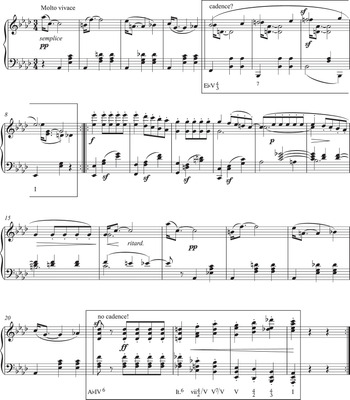
Example 14.3 Robert Schumann, ‘Valse Allemande’, from Carnaval, Op. 9 (1835)
Schubert’s ‘Ihr Bild’ from Schwanengesang (Ex. 14.4) adjusts other aspects of classical practice. The mixture of major and minor modes penetrates the music to an extent that unseats classical orthodoxy, even though Schubert’s harmonic palette is overwhelmingly classical in its details. Modal mixture emerges in the interaction of cadential and pre-cadential harmony. In the setting of stanza 1 in bars 1–12, Schubert slips between an initially established B flat minor and a B flat major secured by a perfect authentic cadence (PAC) in bars 11–12, a setting that recurs verbatim in the final stanza, thereby securing a ternary design, in which stanzas 1 and 3 enfold a middle section in G flat, which sets stanza 2. The pianist’s postlude however undoes the voice’s ostensibly decisive tonic-major PAC, completed by bar 34, by returning to B flat minor, in which mode the song concludes. The methods of prolongation and cadence Schubert employs are wholly classical, but the balance of modes is such that arbitrating between them becomes virtually impossible. If we think that B flat minor is the tonic, then we have to confront the problem that no structural cadence establishes it. If we think B flat major is the tonic, then we need to discount the fact that the song neither begins nor ends in this mode. The frame qualifies the cadences, and the cadences qualify the frame.


Example 14.4 Schubert, ‘Ihr Bild’, from Schwanengesang, D. 957 (1828)
The return to B flat minor for stanza 3 in bars 23–4 moreover discloses a harmonic detail, boxed in Ex. 14.4, which clearly signals Schubert’s post-classical intent. Schubert deploys a chord in bar 23 which has the pitch content of a German augmented sixth but is arranged with B♭ rather than G♭ in the bass, creating an augmented fourth chord defined by the interval between B♭ and E♮. In orthodox circumstances, this chord would resolve onto a cadential 6–4, which then corrects to V. Schubert instead holds the B♭ bass as a common tone and propels the E♮ upwards to F, producing a strongly implied root-position triad of B flat minor, which, however, contains no third. No dominant of B flat minor is subsequently forthcoming: stanza 3 reprises the music of stanza 1 directly in the minor mode. Schubert’s innovation here is not the sonority itself, but its contextual treatment: the augmented sixth is rethought and so, in consequence, is the retransitional approach to the tonic.
By the mid-century, the reconception of classical means had annexed other sonorities. The opening of Liszt’s Faust-Symphonie, first performed in 1857 and quoted in Ex. 14.5, famously liberates the augmented triad from its diatonic constraints. The initial twelve-note theme, comprising the statement and three descending semitonal transpositions of an augmented triad, is, like Schubert’s augmented fourth, radical not because of the triad’s presence, but because of its de-contextualisation. In common-practice usage, augmented triads are formed from the motion either of a chromatic passing note or a suspension, which temporarily generates a triad comprising two major thirds. Ex. 14.6 shows an instance in Mendelssohn’s Lied ohne Worte, Op. 30 No. 3. This is really a progression from V42/ii to ii6 in E, but Mendelssohn delays the leading note’s resolution, creating a downbeat suspension, which temporarily emphasises the augmented triad A-C♯-E♯, before the E♯ moves correctly to its note of resolution, F♯. This is not a triad in its own right, but a sonority formed contrapuntally from the motion of parts between two functional chords.

Example 14.6 Mendelssohn, Lied ohne Worte, Op. 30 No. 3 (1834), bb. 7–11
Liszt’s augmented triads, however, have no diatonic anchorage. They descend in stepwise sequence; and at no point is any pitch revealed as a passing note or suspension in search of resolution towards a major or minor triad. More than this, one particular augmented triad – that founded on E, on which the opening material comes to rest in bar 2 – is effectively the centre of gravity for the introduction’s first thematic paragraph. As Ex. 14.5 reveals, this triad is prolonged, with elaboration, from bar 2 to bar 11, as a simultaneity until bar 7, and then in descending arpeggiation thereafter. Liszt in effect makes a dissonance (the augmented triad) perform a role analogous to the tonic triad in the diatonic common practice.18
The diversity of practices after Faust is clarified by comparison of passages from Brahms’s Violin Sonata, Op. 100, and Mussorgsky’s Boris Godunov, completed in 1887 and 1872, respectively. Opus 100’s first theme (Ex. 14.7) confirms Dahlhaus’s perception that Brahms ‘enriches’ rather than endangers diatonic tonality.19 A major’s tonic status is never in dispute and none of the progressions employed would be out of place in a Mozart sonata. And yet the theme’s idiom is incomprehensible in late-classical terms. Its opening statement, bars 1–5, initiates an entirely orthodox ascending step progression from I to ii; V/ii anticipates a B-minor harmony, which duly arrives at the start of the response phrase in bar 6. Bar 7 finds B minor’s Neapolitan, C major; by bar 8, this has been treated pivotally as IV of G, which is confirmed via its V42 on the last beat of bar 7. The step progression, which at the start was mobilised to produce a I–ii progression, now returns us to A, V of which is attained in bars 9–10. Within ten bars, and without ever threatening A’s stability, Brahms has moved through an interior region of G major which has no close diatonic connection to the tonic.

Example 14.7 Brahms, Violin Sonata in A major, Op. 100 (1886), i, bb. 1–10
The Coronation Scene from Boris Godunov’s Prologue contrasts with Brahms in almost every respect. The entire orchestral introduction, totalling some thirty-eight bars, consists of the alternation of two chords, quoted in Ex. 14.8. According to the notation, these chords are V42 of G, or at least a D dominant seventh chord in its last inversion, and a German augmented sixth chord in C major, spelled with its third in the bass, that is, as an augmented fourth chord. With effort, we could hear this progression in C major, as the alternation of a secondary dominant and an augmented sixth; but nothing in the progression’s context supports this reading. The harmonic oscillation robs both chords of their functional identities; after a while, any expectation that V42/V should resolve to V disperses, as does the perception that the augmented fourth should resolve to V64 in C.
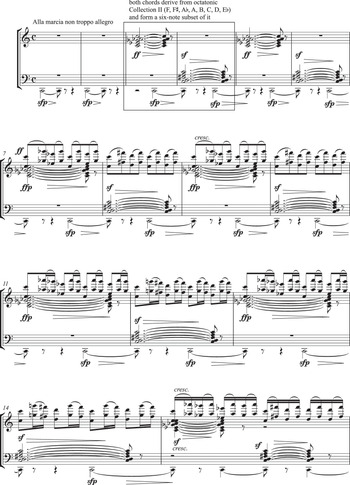
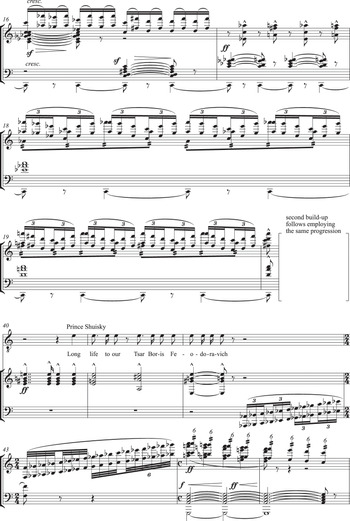
Example 14.8 Mussorgsky, Coronation Scene from Boris Godunov (1872), bb. 1–45
Two factors cause the progression to cohere in the absence of a functional milieu. The first is the common-tone C, which sits beneath the entire passage as a pedal point. The second is the two chords’ membership of the same octatonic collection; as Ex. 14.8 explains, although tritonally distant – their roots are D and A♭ – they both derive from octatonic Collection II, applying Pieter van den Toorn’s terminology, and together comprise a six-note subset of the Collection.20 In a sense, we do not hear this music as diatonically tonal at all, but as projecting a single sonority over time, which is a six-note octatonic surrogate. The music breaks out of this oscillation at bar 40 and becomes wholly triadic, but the sense of diatonic indeterminacy persists, because the progression (E major, C major, A major, E major) favours third relations over any attempt to confirm a tonic via V–I motion.
Taken together, the habits of these composers instantiate many of Romanticism’s major harmonic innovations. Schubert merges major and minor modes; Schubert, Liszt, and Mussorgsky decontextualise common-practice sonorities; Liszt and Mussorgsky liberate dissonances (the augmented triad and the dominant seventh) from tonal functionality; Liszt and Mussorgsky seek alternative foundations for triadic harmony (octatonic and hexatonic); and Brahms exploits diatonic harmony’s multivalence to create chromatic relationships. This new harmonic language is of course also aesthetic, feeding the nineteenth century’s appetite for poetic and programmatic representation and its concern for sonority over functionality. Like Beethoven’s motives and Field’s textures, it instantiates a strikingly post-classical self-reflective musical consciousness, which in this case is a consciousness of tonal harmony as a system subject to historical change.
Form and Narrative
Romanticism’s formal and tonal self-consciousness merges with its literary aspirations in the adaptation of classical forms and genres to poetic and narrative ends. This is especially clear in the development of programme music, most obviously the programme symphonies of Berlioz, which reimagine classical precedents in order to portray the progress of a central protagonist, and Liszt’s symphonic poems, in which he professed to subordinate classical form to the conveyance of a poetic idea.21 Literature’s influence is, however, more pervasive than this: the idea that classical forms could function in analogy with literary or dramatic narratives is, for example, widespread in nineteenth-century symphonies, which nevertheless shun overt programmatic intent. The literary ambitions Schumann nursed for his instrumental forms are especially well documented; as John Daverio argues, the single factor relating all of his output, from the piano cycles of the 1830s to the Faust music and the ‘Rhenish’ Symphony in the 1850s, is ‘the notion that music should be imbued with the same intellectual substance as literature’.22 Daverio sees this mentality emerging in the Papillons of 1831, which rethink the piano cycle as a vehicle for expressing aspects of Jean-Paul Richter’s novel Flegeljahre. As Daverio explains: ‘Papillons shows us a young composer in the process of construing music as literature.’23
In Schumann’s Symphony No. 2, composed in 1845, poetic and narrative impulses jostle with the work’s generic inheritance, resulting in a dense web of musical and extra-musical references. The finale has attracted particular attention in this respect, prompted by its chequered reception history and the difficulty of explaining its form in terms of any one classical paradigm. Anthony Newcomb sought to restore the Symphony’s reputation by pointing out the finale’s narrative implications. For Newcomb, attempts to describe its form in terms of any one model inevitably fail, because they overlook its narrative as well as formal hybridity: ‘the mistake comes in wanting to claim that the finale is in any single form. It starts as one thing and becomes another, and this formal transformation is part of its meaning.’24
Newcomb contends that the movement’s two halves, described in Table 14.2, align with two plot archetypes as well as two possible forms. At the start, the main theme wrong-foots the narrative expectations established by the first, second, and third movements, by moving straight from the tragedy voiced by the C-minor Adagio to an uncomplicated happy ending or lieto fine in C major. Having tended increasingly towards the struggle–victory narrative currency of Beethoven’s Symphony No. 5, Schumann seems at the finale’s outset to have moved to an affirmation of structural security before any moment of overcoming has occurred:
Table 14.2 Schumann, Symphony No. 2, Finale, form (after Newcomb)

If the plot archetype is that of Beethoven’s Fifth – suffering finding its way to strength and health – Schumann’s beginning here may seem an unsatisfactory way of making the crucial move. To bring the strands so carefully together at the end of the third movement only to break them, it seems, with the sharp reversal that greets us at the beginning of the last is much less subtle even than Beethoven’s obvious transition from ghostly lack of vigor at the end of his third movement to triumph at the beginning of the finale.25
In Newcomb’s reading, Schumann’s strategy is to undo the lieto fine as the movement progresses, replacing it with a grand summative finale in Beethoven’s manner. The development sinks to an expressive low point in C minor, recalling the Adagio’s main theme as well as its key, after which the finale’s refrain and its associated rondo form are rejected in favour of a recapitulation and coda dwelling more substantially on the chorale introduced from bar 280, which simultaneously quotes the sixth song of Beethoven’s An die ferne Geliebte and the first movement of Schumann’s own Fantasie, Op. 17. As Newcomb argues: ‘This thematic replacement is paralleled by a formal and generic one. Formally, in the process of the development, rondo elements retreat into the background, and weightier sonata elements … replace them. Generically, the last movement as modest-sized lieto fine becomes the last movement as weighty, reflective summary.’26
Crucial to Newcomb’s reading is the vital role narrativity plays in grasping Schumann’s finale. It is not enough to hear a contribution to the symphony as a musical genre; we have also to hear it as a quasi-literary genre, which engages its generic history in part as a system of plot archetypes. Schumann assumes that his audience will hear the piece in this pseudo-novelistic or dramatic way: as the story of a protagonist, whose ultimate fate can be grasped as the outcome of a narrative. The quotation from An die ferne Geliebte is critical in this respect because it performs several tasks at once. By citing Beethoven, Schumann acknowledges his symphonic precedent; but the fact that his Beethovenian source is a song not a symphony connects the work to a lyric rather than a symphonic heritage, on which Newcomb does not dwell. It is telling in this respect that the Symphony’s other major precedent is Schubert ‘Great’ C major, a piece in the revival of which Schumann played a critical role. Schubert’s model is apparent across Schumann’s Symphony, being evident in the tonality itself, the first movement’s lengthy slow introduction, the focal role played by dance rhythms in the outer movements, and the presence of a minor-mode processional slow movement. The Beethovenian plot archetype to which Newcomb refers coexists with a Schubertian paradigm, the aesthetic of which is ‘lyric-epic’ rather than dramatic, as Dahlhaus says.27 Schumann’s Symphony, in other words, is both a dramatic Beethovenian symphony and a lyric-epic Schubertian symphony; it conflates these two precedents and attempts their synthesis. The quotation from An die ferne Geliebte makes this explicit: Beethoven, Schumann tells us, is a source for the lyric as well as the dramatic. A symphonic transformation of Beethoven’s song is the agent of the Symphony’s formal salvation. It is through the lyric’s intervention that the premature lieto fine is undone.
The song reference allows Schumann to address another precedent, on which Newcomb is also mute. The Symphony No. 2 has an instrumental finale, but its vocal resonances inevitably raise the spectre of Beethoven’s Symphony No. 9. Like Brahms’s Symphony No. 1 thirty years later, Schumann alludes to a vocal Beethovenian source in order to legitimise a purely instrumental finale. The lyric, Schumann suggests, is the means by which the instrumental symphony can transcend Beethoven’s transcendence of the instrumental in his Ninth. At a single stroke, Schumann fuses Beethovenian and Schubertian precedents in a strategy that also confirms the instrumental symphony’s aesthetic legitimacy. This manoeuvre is confirmed in bars 544–51 in the coda, where, as Douglass Seaton notes, the falling thirds with which Beethoven twice sets ‘alle Menschen’ towards the end of the Ninth’s finale are retrieved as purely instrumental material.28
Conclusions
Of course, Romanticism’s heightened awareness of means and meaning is attended by broader historical discourses, which it is now commonplace to treat with scepticism, if not outright condemnation. Schoenberg’s argument for the historical necessity of atonality is perhaps their most well-known outcome. Its problematic Hegelianism has long been acknowledged: Richard Taruskin dismisses it as a kind of myth-making, in which ‘ontogeny’ (the development of Schoenberg’s musical style) is mistaken for ‘phylogeny’ (the development of Western music in general).29 More controversial still in light of recent decolonial scholarship is the intersection of music and race in nineteenth-century discourse. Fétis’s tonal theory was, for example, partnered with a conception of history which qualitatively differentiated musical practices according to ‘innate’ racial capacities. By this argument, European music emerged as superior, thanks to the superior cranial and mental capacities of ‘Aryan’ peoples.30 The Romantic tendency to historicise and taxonomise music in a racially hierarchical way supplies an epistemic context in which accelerating experimentation with music’s ‘language’ takes place. As Gary Tomlinson has stressed, this context is ultimately grounded in Europe’s developing tendency to perceive its culture and polity as ‘unique and superior’, a self-perception that also underwrote its burgeoning colonialism.31
Respectively problematic and repugnant as these modes of thought now seem, the wholesale critique of Romantic music on decolonial grounds is hard to sustain, because its cultural diversity resists classification under a monolithic notion of imperialism. The Bonn into which Beethoven was born was an electorate of the Holy Roman Empire, a loose polity at best, which had dissolved by the time of Beethoven’s death in 1827 in Vienna, itself the capital of a wholly European empire that had little in common with the colonial trading empires of Britain, France, and the Netherlands. The duress of French imperialism was a recurrent feature of Beethoven’s adult life. The threat of French invasion hung over Bonn in 1792, when Beethoven left for Vienna, and the city was incorporated into the First French Empire in 1794; Vienna was twice captured by Napoleon while Beethoven lived there, in 1805 and 1809. Field, in contrast, was born in Dublin in 1782, during a period of increasing parliamentary independence from England, but left Ireland for London in 1793 and London for St Petersburg in 1802, remaining in Russia until his death in 1837, by which time the Acts of Union had quashed fledgling Irish independence. There is no binding concept of ‘empire’, which contains Beethoven and Field, notwithstanding a reception history that sees Beethoven especially as the world-historical Western European composer. And it is very unclear how Field’s Anglo-Hibernian/Russian contexts and Beethoven’s Hapsburg context could be merged with that of Fétis, whose Traité was published in 1844 during the period of the July Monarchy in France.
Even if Beethoven, Field, Schubert, Liszt, Brahms, Mussorgsky, and Schumann could all be ramified within an encompassing imperialism, an awareness of this context does not help us to decode the particularity of Romanticism’s musical languages, because the connections between ideology and technique are associative, not causative: historical research will never demonstrate that Fétis’s European supremacism or any comparable ideology motivates all Romantic harmonic, formal, or textural innovations beyond classical precedent. We can and should recognise the complicity of musical Romanticism’s discourses with colonialism where it is manifest. But the sheer diversity of Romanticism’s musical languages frustrates explanation in terms of any totalising disciplinary imperative.

